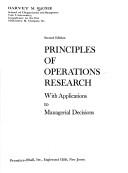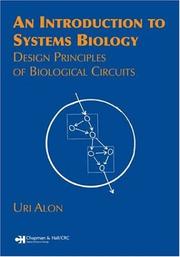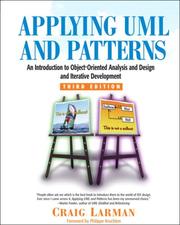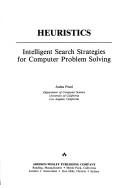| Listing 1 - 10 of 10 |
Sort by
|
Book
ISBN: 0132932261 Year: 1993 Publisher: Englewood Cliffs Prentice Hall Inc
Abstract | Keywords | Export | Availability | Bookmark
 Loading...
Loading...Choose an application
- Reference Manager
- EndNote
- RefWorks (Direct export to RefWorks)
matlab --- Computerprogramma's. --- Lineaire regelsystemen. --- Linear systems --- Matlab. --- Ontwerpen. --- Computer-aided design. --- Systems, Linear --- Differential equations, Linear --- System theory --- Computer-aided design --- Automatic control. --- MATLAB. --- MATLAB (Computer program) --- Matrix laboratory --- MATLAB (Computer file)

ISBN: 0137095279 0137095929 9780137095278 9780137095926 Year: 1975 Publisher: Englewood Cliffs, N.J. : Prentice-Hall,
Abstract | Keywords | Export | Availability | Bookmark
 Loading...
Loading...Choose an application
- Reference Manager
- EndNote
- RefWorks (Direct export to RefWorks)
Operational research. Game theory --- Operations research --- Management science --- Sociologisch onderzoek 303.1 --- Sociologie 30 --- 518.5 --- 65.012.122 --- Operationeel onderzoek --- Operational analysis --- Operational research --- Industrial engineering --- Research --- System theory --- Operationeel onderzoek. Speltheorie --- Operations research. --- Recherche opérationnelle --- Prise de décision --- Programmation (mathématiques)

ISBN: 0521606373 9780521606370 0521844649 9780521844642 9780511734892 0511838700 1316175073 1316170756 1316176282 1316173976 131617249X 1316178145 0511734891 9781316178140 9781316172490 1322177686 Year: 2005 Publisher: Cambridge : Cambridge University Press,
Abstract | Keywords | Export | Availability | Bookmark
 Loading...
Loading...Choose an application
- Reference Manager
- EndNote
- RefWorks (Direct export to RefWorks)
Can we understand important social issues by studying individual personalities and decisions? Or are societies somehow more than the people in them? Sociologists have long believed that psychology can't explain what happens when people work together in complex modern societies. In contrast, most psychologists and economists believe that if we have an accurate theory of how individuals make choices and act on them, we can explain pretty much everything about social life. Social Emergence takes a new approach to these longstanding questions. Sawyer argues that societies are complex dynamical systems, and that the best way to resolve these debates is by developing the concept of emergence, focusing on multiple levels of analysis - individuals, interactions, and groups - and with a dynamic focus on how social group phenomena emerge from communication processes among individual members. This book makes a unique contribution not only to complex systems research but also to social theory.
316.32 --- Globale samenlevingsvormen --- Communication --- Social evolution. --- Social systems. --- Sociology. --- Social aspects. --- 316.32 Globale samenlevingsvormen --- Social evolution --- Social systems --- Sociology --- Social theory --- Social sciences --- System theory --- Cultural evolution --- Cultural transformation --- Culture, Evolution of --- Culture --- Evolution --- Social change --- Communication and culture --- Social aspects --- Social Sciences
Book
ISBN: 9789077442326 9789401425766 Year: 2007 Publisher: Leuven Houten LannooCampus Bohn Stafleu Van Loghum
Abstract | Keywords | Export | Availability | Bookmark
 Loading...
Loading...Choose an application
- Reference Manager
- EndNote
- RefWorks (Direct export to RefWorks)
De grondlegger van de hechtingstheorie, John Bowlby, onderzocht en beschreef de fundamentele behoefte van kinderen om zich te hechten aan hun ouders. Dit hechtingsgebeuren vindt plaats binnen het intieme netwerk van gezinsrelaties, waarin elk kind geboren wordt en opgroeit. Lange tijd beperkte het onderzoek naar hechtingsprocessen zich tot de relatie tussen een kind en zijn moeder, waarbij de aandacht vooral naar de intrapsychische belevingswereld van onveilig gehechte kinderen en volwassenen ging. Pas in later onderzoek was er veel meer oog voor de impact van gezinsfactoren die het hechtingsgebeuren beïnvloeden. Toch bleven tot voor enkele jaren de hechtingstheorie en de systeemtheorie twee gescheiden werelden. Onder impuls van een groeiende groep van clinici, worden de verworvenheden van de hechtingstheorie geïntegreerd binnen een systeemtherapeutisch denkmodel. Deze systeemtherapeuten breidden het concept van gehechtheid uit naar het gezinssysteem als geheel. Hechtingsproblemen in gezinnen beschrijft allereerst de integratie van de hechtingstheorie binnen het gezinssysteem. Daarnaast wordt aandacht besteed aan gehechtheid binnen veilige en onveilige gezinssituaties. De auteur benadert de hechtingstheorie niet vanuit de gedachte dat kinderen slachtoffers kunnen zijn van een onveilige omgeving. Hij gaat er vooral van uit dat kinderen, met hun eigen temperament en karakter, actief deelnemen aan de vorming van hechtingspatronen binnen het gezin. Dit boek is bestemd voor hulpverleners die de hechtingstheorie op een kritische en gedifferentieerde manier willen toepassen in counseling en psychotherapie. Door de gedegen samenvattingen van belangrijke theorieën uit het werkveld is het tevens zeer geschikt als leerboek in de opleiding tot behandelaar. (Bron: covertekst)
Emotionele stoornissen --- Gezin --- Gezinstherapie. --- Kinderen. --- Systeemtherapie. --- gezinstherapie --- hechting (psychologie) --- Psychiatry --- systeemtherapie --- bodemloosheidsyndroom --- Attachment behavior --- Family psychotherapy --- System theory --- 607.43 --- gezin --- hechtingsstoornissen --- 159.922 --- Gehechtheid --- Gezinstherapie --- Jeugdhulpverlening --- Kinderen --- Ontwikkeling --- Relatietherapie --- hechtingsproblemen --- Systeemdenken --- Systeemtherapie --- Hechting --- Psychotherapie --- Hechtingstheorie --- Gezinszorg --- Hechting (psychologie) --- Thuiszorg --- Ouderenzorg --- Hechtingsstoornissen --- psychotherapieën, overige --- hechting --- psychotherapie --- 615.88

ISBN: 1584886420 9781584886426 Year: 2007 Volume: 10 Publisher: Boca Raton London New York : Chapman & Hall/CRC,
Abstract | Keywords | Export | Availability | Bookmark
 Loading...
Loading...Choose an application
- Reference Manager
- EndNote
- RefWorks (Direct export to RefWorks)
This book presents recently discovered design principles that govern the structure and behavior of biological networks such as gene circuits, highlighting simple, recurring circuit elements that make up the network. It provides a quantitative theory for which circuits are found in a given environment and a mathematical framework for understanding and even designing biological circuits. The book requires only basic mathematics and includes a review of the necessary background material. It fills a significant need for a textbook and introduction to the concepts, principles, and mathematical tools that will form the basis of future developments in the field. An Introduction to Systems Biology: Design Principles of Biological Circuits builds a solid foundation for the intuitive understanding of general principles. It encourages the reader to ask why a system is designed in a particular way and then proceeds to answer with simplified models. ÂExplains the basic circuitry in transcription regulation, signal transduction, and developmental networks ÂIncludes examples ranging from bacterial chemotaxis through developmental patterning and neuronal circuits to immune recognition ÂExamines the principle of robustness ÂDetails how constrained evolutionary optimization can be used to understand optimal circuit design ÂConsiders how kinetic proofreading and other mechanisms can minimize errors made in biological information-processing ÂIncludes solved problems after each chapter that detail topics not discussed in the main text Thorough and accessible, this book presents the design principles of biological systems, and highlights the recurring circuit elements that make up biological networks. It provides a simple mathematical framework which can be used to understand and even design biological circuits. The text avoids specialist terms, focusing instead on several well-studied biological systems that concisely demonstrate key principles.
Biomathematics. Biometry. Biostatistics --- Mathematical statistics --- Computational biology --- Biological systems --- Bio-informatique --- Systèmes biologiques --- Mathematical models --- Modèles mathématiques --- Systems biology --- Cellule --- cells --- Biologie --- biology --- Développement biologique --- biological development --- Réseau de neurones --- Neural networks --- Mécanisme chimiotactique --- Chemotaxis --- Facteur de transcription --- Transcription factors --- Immunogénétique --- Immunogenetics --- Expression des gènes --- gene expression --- Biosystems --- Systems, Biological --- Biology --- System theory --- Philosophy --- Computational biology. --- Systems biology. --- Basic Sciences. Biology --- Mathematical models. --- Biosystematics --- Biosystematics. --- Systèmes biologiques --- Modèles mathématiques --- Bioinformatics --- Molecular biology --- Biological systems - Mathematical models

ISBN: 1593851146 Year: 2005 Publisher: New York London : The Guilford Press,
Abstract | Keywords | Export | Availability | Bookmark
 Loading...
Loading...Choose an application
- Reference Manager
- EndNote
- RefWorks (Direct export to RefWorks)
What principles should guide an empowerment evaluation? And how can these principles actually be put into practice? One of the primary tasks in an empowerment evaluation (EE) is to increase the capacity of program stakeholders to plan, implement, and evaluate their own programs. This book presents the most current formulation of the 10 principles of EE and provides professionals and students with the tools to put these principles into practice. Through case studies of diverse evaluation projects—including community health foundation initiatives, school district programs, and a $15 million corporate program aimed at bridging the digital divide—the founder and leading proponents of EE clarify key concepts and discuss important lessons learned. Coverage includes how to balance program improvement efforts with accountability requirements; how EE can be used to guide standards-based work; how to use EE in a learning organization; the differences among empowerment, collaborative, and participatory evaluation; and much more.
#SBIB:303H60 --- #SBIB:35H415 --- Bijzondere methoden: algemeen --- Beleidscyclus: evaluatie --- Evaluatie --- Empowerment --- Evaluation research (Social action programs) --- Organization. --- Industrial organization. --- Social systems. --- Employee empowerment. --- Human services --- Evaluation. --- Evaluatie. --- Empowerment. --- Evaluation research (Social action programs). --- Employee empowerment --- Industrial organization --- Organization --- Social systems --- Industries --- Industrial concentration --- Industrial management --- Industrial sociology --- Services, Human --- Sociology --- System theory --- Organisation --- Management --- Evaluation of social action programs --- Evaluative research (Social action programs) --- Evaluation --- Social action --- Social sciences --- Social service --- Empowerment, Employee --- Delegation of authority --- Research --- Employee participation

ISBN: 1852336943 9780857293985 9781852336943 0857293982 Year: 2004 Publisher: London : Springer,
Abstract | Keywords | Export | Availability | Bookmark
 Loading...
Loading...Choose an application
- Reference Manager
- EndNote
- RefWorks (Direct export to RefWorks)
From power plants to sugar refining, model predictive control (MPC) schemes have established themselves as the preferred control strategies for a wide variety of processes. The second edition of Model Predictive Control provides a thorough introduction to theoretical and practical aspects of the most commonly used MPC strategies. It bridges the gap between the powerful but often abstract techniques of control researchers and the more empirical approach of practitioners. Model Predictive Control demonstrates that a powerful technique does not always require complex control algorithms. The text features material on the following subjects: general MPC elements and algorithms; commercial MPC schemes; generalized predictive control multivariable, robust, constrained nonlinear and hybrid MPC; fast methods for MPC implementation; applications. All of the material is thoroughly updated for the second edition with the chapters on nonlinear MPC, MPC and hybrid systems and MPC implementation being entirely new. Many new exercises and examples have also have also been added throughout and MATLAB® programs to aid in their solution can be downloaded from extras.springer.com. The text is an excellent aid for graduate and advanced undergraduate students and will also be of use to researchers and industrial practitioners wishing to keep abreast of a fast-moving field.
Predictive control. --- Modelvorming --- Optimalisering --- Procesregeling --- Stochastische processen --- Modelvorming. --- Optimalisering. --- Procesregeling. --- Stochastische processen. --- Systems Theory, Control. --- Systems theory. --- Predictive control --- Model based predictive control --- Model predictive control --- Engineering. --- Chemical engineering. --- System theory. --- Control engineering. --- Electronics. --- Microelectronics. --- Control. --- Industrial Chemistry/Chemical Engineering. --- Electronics and Microelectronics, Instrumentation. --- Microminiature electronic equipment --- Microminiaturization (Electronics) --- Electronics --- Microtechnology --- Semiconductors --- Miniature electronic equipment --- Electrical engineering --- Physical sciences --- Control engineering --- Control equipment --- Control theory --- Engineering instruments --- Automation --- Programmable controllers --- Systems, Theory of --- Systems science --- Science --- Chemistry, Industrial --- Engineering, Chemical --- Industrial chemistry --- Engineering --- Chemistry, Technical --- Metallurgy --- Construction --- Industrial arts --- Technology --- Philosophy --- Control and Systems Theory. --- Control theory. --- Chemistry, Technical. --- Systems Theory, Control . --- Industrial Chemistry. --- Dynamics --- Machine theory --- Chemical technology --- Technical chemistry --- Chemistry --- Chemical engineering

ISBN: 0131489062 9780131489066 Year: 2005 Publisher: Upper Saddle River, N.J. : Prentice Hall PTR,
Abstract | Keywords | Export | Availability | Bookmark
 Loading...
Loading...Choose an application
- Reference Manager
- EndNote
- RefWorks (Direct export to RefWorks)
This third edition again delivers a clear path for students and professionals to learn and apply object-oriented analysis and design. The first two editions of this book have achieved gross sales of more than 60,000 units through the domestic retail channel Timely and up-to-date; compliant with UML 2.0 and the latest trends in design patterns and object-oriented analysis and design More gold from one of the leading names in software engineering- Craig Larman! The mastery of object-oriented analysis and design (OOA/D) principles and concepts is critical for anyone seeking to create robust and maintainable object systems. This third edition presents a well-defined roadmap, so the reader can move along a step-by-step process from requirements gathering all the way to code generation. The author teaches the skill of OOA/D using the latest version of the industry standard modeling language (UML 2.0). He also allows the reader to learn and apply the popular concept of design patterns, and therefore helps readers accelerate their mastery of analysis and design. The author retains his thorough treatment of a single case study to help readers gain a big picture of successful software development. Once again, this book delivers, and furthers Craig Larman's name among software engineering luminaries.
Programming --- Computer architecture. Operating systems --- Object-georiënteerd programmeren --- objectgeoriënteerde systeemontwikkeling --- visuele modelleertalen --- computerarchitectuur --- 521 --- 525.1 --- Languages constructs: abstract data types concurrent programming structurescontrol structures coroutines (Programming languages) --- systeemanalyse, systeemontwerp, beheer en onderhoud van informatiesystemen --- Object-georiënteerd programmeren. --- 681.3*D33 Languages constructs: abstract data types concurrent programming structurescontrol structures coroutines (Programming languages) --- 681.3*D33 --- 681.3*D211 --- UML --- programmeertalen --- programmeren --- besturingssystemen --- systeemanalyse --- systeemontwerp --- informatica --- 525.5 --- infobib --- 681.3.06 --- Objectgeoriënteerd programmeren --- Programmeertalen : UML --- 681.3*D33 Languages constructs: abstract data types; concurrent programming structures;control structures; coroutines (Programming languages) --- Languages constructs: abstract data types; concurrent programming structures;control structures; coroutines (Programming languages) --- Software architectures: data abstractio, domain-specific architectures, information hiding, languages (e.g. description, interconnection, definition), patterns (e.g. client/server, pipeline, blackboard) --- C (informatica) --- object oriented analysis --- UML (unified modeling language) --- Object-oriented methods (Computer science) --- System analysis --- System design --- UML (Computer science) --- Object development methods (Computer science) --- Object orientation (Computer science) --- Object-oriented development (Computer science) --- Object technology (Computer science) --- Unified Modeling Language (Computer science) --- Computer software --- Modeling languages (Computer science) --- Design, System --- Systems design --- Electronic data processing --- Network theory --- Systems analysis --- System theory --- Mathematical optimization --- Development --- Network analysis --- Network science --- System analysis. --- Object-oriented methods (Computer science). --- System design. --- UML (Computer science). --- 004.4 --- Informatica --- Programmeertalen --- Programmeren --- Systeemontwikkeling
Book
ISBN: 9781603580557 1603580557 Year: 2008 Publisher: White River Junction, Vt. : Chelsea Green Pub.,
Abstract | Keywords | Export | Availability | Bookmark
 Loading...
Loading...Choose an application
- Reference Manager
- EndNote
- RefWorks (Direct export to RefWorks)
Thinking in Systems, is a concise and crucial book offering insight for problem solving on scales ranging from the personal to the global. Edited by the Sustainability Institute's Diana Wright, this essential primer brings systems thinking out of the realm of computers and equations and into the tangible world, showing readers how to develop the systems-thinking skills that thought leaders across the globe consider critical for 21st-century life. Some of the biggest problems facing the world―war, hunger, poverty, and environmental degradation―are essentially system failures. They cannot be solved by fixing one piece in isolation from the others, because even seemingly minor details have enormous power to undermine the best efforts of too-narrow thinking. While readers will learn the conceptual tools and methods of systems thinking, the heart of the book is grander than methodology. Donella Meadows was known as much for nurturing positive outcomes as she was for delving into the science behind global dilemmas. She reminds readers to pay attention to what is important, not just what is quantifiable, to stay humble, and to stay a learner. In a world growing ever more complicated, crowded, and interdependent, Thinking in Systems helps readers avoid confusion and helplessness, the first step toward finding proactive and effective solutions.
systeemdenken --- Business management --- Operational research. Game theory --- System analysis --- Decision making --- Critical thinking --- Sustainable development --- Social sciences --- Economic development --- Population --- Pollution --- Environmental education --- Analyse de systèmes --- Prise de décision --- Pensée critique --- Développement durable --- Sciences sociales --- Développement économique --- Environnement --- Simulation methods --- Simulation methods. --- Environmental aspects --- Economic aspects --- Méthodes de simulation --- Simulation, Méthodes de --- Aspect de l'environnement --- Aspect économique --- Etude et enseignement --- 518.5 --- 658.012 --- 338 --- 130 --- economische ontwikkelingen --- 001.8 --- 001.8 Methodologie in de wetenschap --- Methodologie in de wetenschap --- Operationeel onderzoek. Speltheorie --- Planning in het bedrijf --- Economische toestand. Economische ontwikkeling --- Analyse de systèmes --- Prise de décision --- Pensée critique --- Développement durable --- Développement économique --- Méthodes de simulation --- Simulation, Méthodes de --- Aspect économique --- Chemical pollution --- Chemicals --- Contamination of environment --- Environmental pollution --- Contamination (Technology) --- Asbestos abatement --- Bioremediation --- Environmental engineering --- Environmental quality --- Factory and trade waste --- Hazardous waste site remediation --- Hazardous wastes --- In situ remediation --- Lead abatement --- Pollutants --- Refuse and refuse disposal --- Education --- Development, Economic --- Economic growth --- Growth, Economic --- Economic policy --- Economics --- Statics and dynamics (Social sciences) --- Development economics --- Resource curse --- Critical reflection --- Reflection (Critical thinking) --- Reflection process --- Reflective thinking --- Thinking, Critical --- Thinking, Reflective --- Thought and thinking --- Reflective learning --- Network theory --- Systems analysis --- System theory --- Mathematical optimization --- Development, Sustainable --- Ecologically sustainable development --- Economic development, Sustainable --- Economic sustainability --- ESD (Ecologically sustainable development) --- Smart growth --- Sustainable economic development --- Human population --- Human populations --- Population growth --- Populations, Human --- Human ecology --- Sociology --- Demography --- Malthusianism --- Environmental aspects&delete& --- Economic aspects&delete& --- Network analysis --- Network science --- opleiding elektromechanica --- simulation methods --- systems analysis --- sustainable development --- Organization theory --- Evaluative thinking --- System analysis - Simulation methods --- Decision making - Simulation methods --- Critical thinking - Simulation methods --- Sustainable development - Simulation methods --- Social sciences - Simulation methods --- Economic development - Environmental aspects - Simulation methods --- Population - Economic aspects - Simulation methods --- Pollution - Economic aspects - Simulation methods --- Environmental education - Simulation methods --- Approche systémique

ISBN: 0201055945 9780201055948 Year: 1985 Publisher: Reading (Mass.): Addison-Wesley
Abstract | Keywords | Export | Availability | Bookmark
 Loading...
Loading...Choose an application
- Reference Manager
- EndNote
- RefWorks (Direct export to RefWorks)
Heuristic programming --- Operations research --- Problem solving --- -681.3*F22 --- 681.3*G16 --- 681.3*I28 --- Methodology --- Psychology --- Decision making --- Executive functions (Neuropsychology) --- Operational analysis --- Operational research --- Industrial engineering --- Management science --- Research --- System theory --- Artificial intelligence --- Programming (Mathematics) --- Data processing --- Nonnumerical algorithms and problems: complexity of proof procedures computations on discrete structures geometrical problems and computations pattern matching --See also {?681.3*E2-5} {681.3*G2} {?681.3*H2-3} --- Optimization: constrained optimization gradient methods integer programming least squares methods linear programming nonlinear programming (Numericalanalysis) --- Problem solving, control methods and search: backtracking dynamic program- ming graph and tree search strategies heuristics plan execution, formationand generation (Artificial intelligence)--See also {681.3*F22} --- Artificial intelligence. --- Heuristic programming. --- Operations research. --- Data processing. --- 681.3*I28 Problem solving, control methods and search: backtracking dynamic program- ming graph and tree search strategies heuristics plan execution, formationand generation (Artificial intelligence)--See also {681.3*F22} --- 681.3*G16 Optimization: constrained optimization gradient methods integer programming least squares methods linear programming nonlinear programming (Numericalanalysis) --- 681.3*F22 Nonnumerical algorithms and problems: complexity of proof procedures computations on discrete structures geometrical problems and computations pattern matching --See also {?681.3*E2-5} {681.3*G2} {?681.3*H2-3} --- 681.3.069 --- Artificiële Intelligentie --- AI (Artificial intelligence) --- Artificial thinking --- Electronic brains --- Intellectronics --- Intelligence, Artificial --- Intelligent machines --- Machine intelligence --- Thinking, Artificial --- Bionics --- Digital computer simulation --- Logic machines --- Machine theory --- Self-organizing systems --- Fifth generation computers --- Neural computers --- Kunstmatige intelligentie --- Speltheorie --- Zoekmethoden --- Zoekstrategie (operations research) --- Kunstmatige intelligentie. --- Speltheorie. --- Zoekmethoden. --- Zoekstrategie (operations research). --- 681.3*F22 --- 681.3*G16 Optimization: constrained optimization; gradient methods; integer programming; least squares methods; linear programming; nonlinear programming (Numericalanalysis) --- Optimization: constrained optimization; gradient methods; integer programming; least squares methods; linear programming; nonlinear programming (Numericalanalysis) --- Cognitive science --- Electronic data processing --- Simulation methods --- 681.3*I28 Problem solving, control methods and search: backtracking; dynamic program- ming; graph and tree search strategies; heuristics; plan execution, formationand generation (Artificial intelligence)--See also {681.3*F22} --- Problem solving, control methods and search: backtracking; dynamic program- ming; graph and tree search strategies; heuristics; plan execution, formationand generation (Artificial intelligence)--See also {681.3*F22} --- 681.3*F22 Nonnumerical algorithms and problems: complexity of proof procedures; computations on discrete structures; geometrical problems and computations; pattern matching --See also {?681.3*E2-5}; {681.3*G2}; {?681.3*H2-3} --- Nonnumerical algorithms and problems: complexity of proof procedures; computations on discrete structures; geometrical problems and computations; pattern matching --See also {?681.3*E2-5}; {681.3*G2}; {?681.3*H2-3} --- 519.8 --- 681.3*I --- 681.3*I Computing methodologies --- Computing methodologies --- 519.8 Operational research --- Artificial intelligence. Robotics. Simulation. Graphics --- Problem solving - Data processing
| Listing 1 - 10 of 10 |
Sort by
|

 Search
Search Feedback
Feedback About
About Help
Help News
News